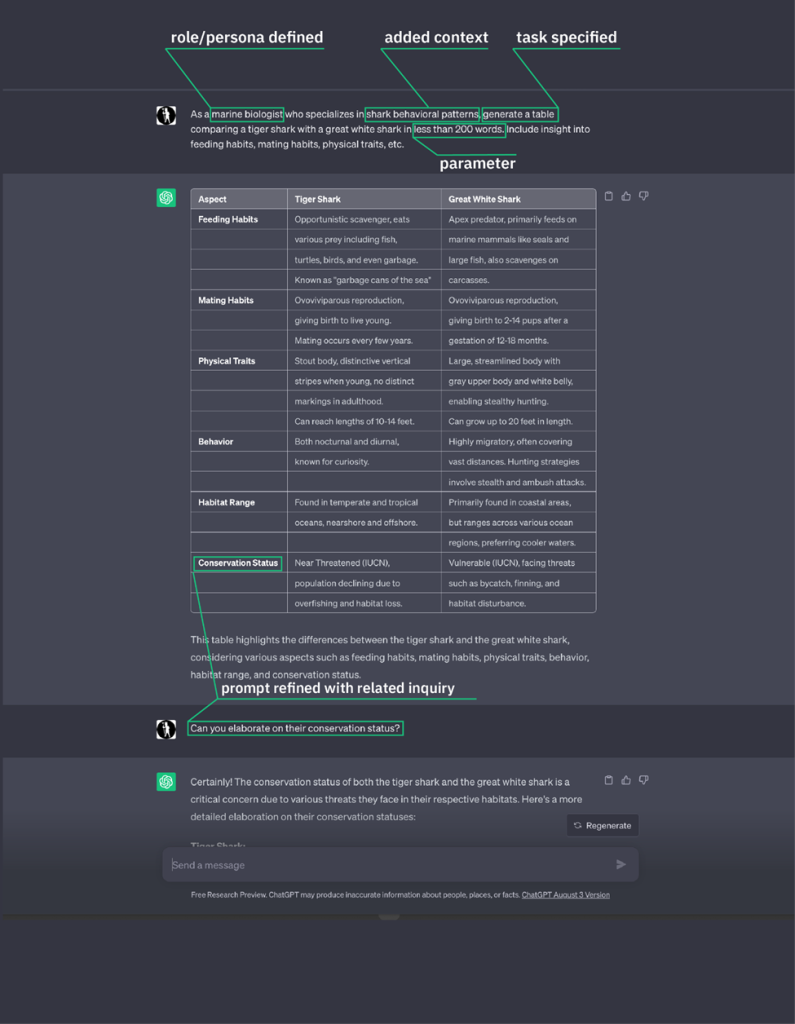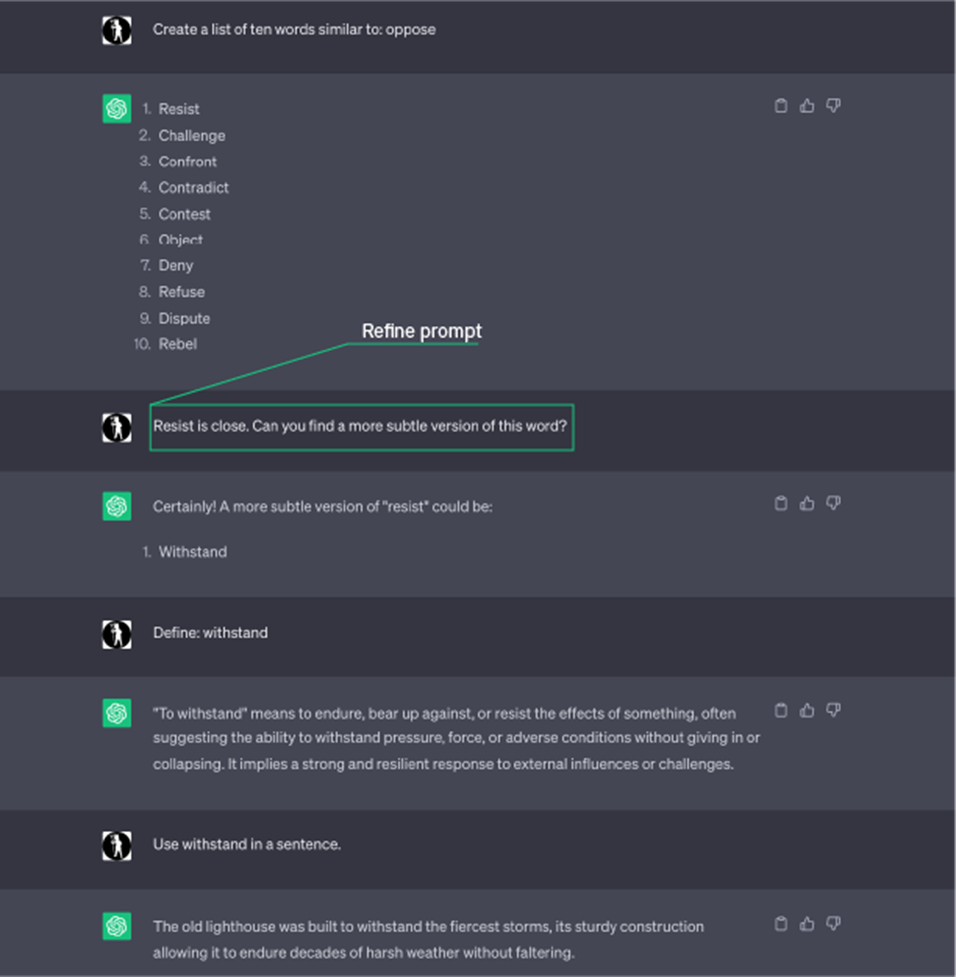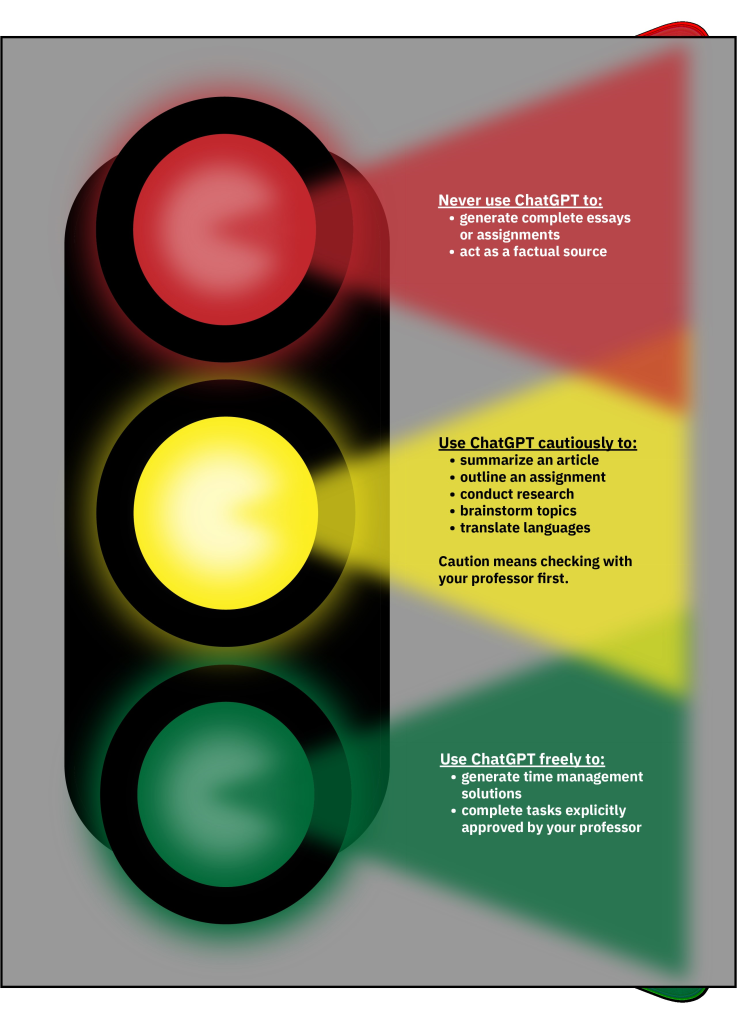Making it Work: ChatGPT and Your College Assignments

Table of Contents
- Introduction
- What is Artificial Intelligence (AI)?
- Overview of ChatGPT
- Using ChatGPT as a Writing Tool
- Using ChatGPT Ethically
- Assessing the Reliability of Resources Using AI
- Citing Information Generated by an AI Chatbot
- Conclusion
Introduction
ChatGPT launched in 2022 and quickly made headlines as a tool with exciting possibilities that also raises many concerns, particularly in education. While students can use ChatGPT to conduct research, write papers, and even create code, they also can use it to plagiarize and cheat.
This guide offers a basic overview of ChatGPT and provides some guidance for responsible use within a college setting. You can click on any section of the table of contents to quicly get the information you need.
What is Artificial Intelligence (AI)?
What comes to mind when you think of artificial intelligence? Sentient robots who possess the same level of cognition as humans, perhaps even exceeding our own capabilities? Sci-fi movies commonly portray AI as this out-of-control technology, but that is not the reality.
Rather, think about automated machines that make our lives easier, eliminating mundane tasks so we can focus on what truly matters. Ever asked Alexa or Siri to play your favorite song or find the closest Starbucks? These digital assistants are made possible by AI. But what exactly is it?
Artificial intelligence is a computer simulation of human intelligence that is made possible by training machines to respond to input in a manner similar to humans. Technically speaking, a computer algorithm perceives information from sensors, like a microphone or camera, and analyzes it in an instant to produce an output. The machine’s algorithm then learns through repeating this process over and over again, intuitively adapting its responses along the way. The function of the algorithm is analogous to the function of our brain.
Self-driving cars, for example, are able to recognize objects like stop signs and respond promptly and appropriately. This is because their AI program has been fed so many examples of stop signs that it can make a good guess about whether an object it has never seen before fits the pattern and what to do in response to that pattern. Through the use of AI, we are able to use complex technology without even knowing we are.
Although robots will not be taking over anytime soon, there are some very real ethical dilemmas that surround the use of artificial intelligence. Smart cities that pair AI with cameras, like Amazon Go, bring up concerns about invasion of privacy. Companies know a lot about us and use this information for ad targeting and other advantageous reasons. Along with this, databases may not be up to date, which leaves room for bias and inaccuracies. This makes AI a potential socio-political issue, especially when used in areas like government and education. Most recently, the chatbot ChatGPT has sparked much debate. Especially when it comes to higher education.
Overview of ChatGPT
What is ChatGPT?
Let’s start by taking a look at ChatGPT to understand what it is and how it works. Chat GPT is a form of generative AI, which is artificial intelligence that generates images and text based on learning models. ‘Chat’ refers to the chatbot function while GPT stands for Generative Pre-Trained Transformer, which is the learning model used to generate a response.
As a chatbot, ChatGPT functions like the automated customer service chat services that pop up on many consumer sites. However, ChatGPT’s abilities to communicate with the user and generate text are far more sophisticated than these chatbots. In response to user prompts, ChatGPT can generate research reports, essays, creative works of fiction or poetry, recipes, instructions, and even do basic coding. It can also engage in back-and-forth dialogue with the user, so you can ask follow-up questions or request clarification on a response. Pretty cool, huh?
So how does it work? For a more in-depth look at the technology behind ChatGPT, take a look at Stephen Wolfram’s explainer, but the short answer is that it uses a predictive model to generate text. In the same way that Word or Gmail will suggest the next words and phrases in your sentences based upon what you’ve written, ChatGPT generates answers by predicting the next sequence of text. The sophistication comes through its ability to access a broad range of information and to vary language in such a way that it sounds human.
ChatGPT is also user friendly with an accessible interface and simple command system. Let’s take a look.
Setting up a ChatGPT Account
Users can access ChatGPT here. You will need to start by creating an account. This is a relatively straightforward process that requires users to enter their name, email address and create a password. OpenAI, the company that created ChatGPT, will have users ‘okay’ a series of prompts before accessing the tool:

The first prompt reminds users that ChatGPT is still in a research stage, which means that information may be incorrect. Users are essentially participating in a trial, and it is important to keep that in mind when conducting a search.
The second prompt lets users know that conversations are being reviewed by ChatGPT designers. Again, this is still in a research period and user participation helps creators identify and correct errors. You should not share any private or sensitive information.
Finally, you are welcome to provide OpenAI with feedback. If you have a particularly good experience with ChatGPT or if you receive a problematic response, let them know. It will help them make improvements.
Conducting a ChatGPT Search
Once into ChatGPT, users simply need to enter a question into the ‘Send a Message’ cell at the bottom of the screen. This can be a question (“What does the color green represent in The Great Gatsby?”) or a prompt (“Describe how to make gluten free cookies”). If you want to ask a follow up question, continue entering prompts into the cell. Previous queries are noted in the black sidebar, so you can pull up earlier searches to access that information or continue the dialogue.

Generating Productive Responses
While you can enter questions or prompts in any format, keep the following in mind to get the most accurate responses:
1. ChatGPTonly has data up to the year 2021, so if you are asking questions that require more updated information, such as those pertaining to current events or recent scientific theories or developments, you will need to look elsewhere.
2. Keep your questions as straightforward as possible. Including too many factors will confuse ChatGPT, and this can produce unclear or inaccurate information.
3. Avoid vague or open-ended questions that do not provide enough information.
4. Avoid niche questions. While ChatGPT’s knowledge database is expansive, it may not be able to answer focused questions relevant to specific fields.
5. There are also some queries ChatGPT won’t respond to, including those that promote hate and/or that can lead to harm. Access the full list of off-limit topics here.
Verifying ChatGPT Information
Keep in mind that ChatGPT can only access information on which it has been trained, so responses may be partial, outdated, incorrect, plagiarized, and/or they can contain bias. To learn more about how you can fact check ChatGPT’s responses, check out our section on Assessing the Reliability of Resources Using AI.
Using ChatGPT as a Writing Tool
As a writer, it is up to you to define your boundaries for use of ChatGPT and your work. Refer to the Ethical uses of ChatGPT chapter for further details.
Your professor or institution may also have rules regarding use of ChatGPT, so please refer to those rules where necessary.
ChatGPT has many tools writers can use for crafting their work. Here is an overview of some of the tools and techniques you may find useful.
Writing Effective ChatGPT Prompts
The first step in using ChatGPT is understanding how to converse with the chatbot to get the best results.
- Define a role or persona – “As a marine biologist, describe the effect of global warming on the oceans.”
- Provide context – relevant context is important to help ChatGPT come to the most accurate response.
- Specify a task – use action words to guide ChatGPT: “summarize”, “write”, “compare”…
- Include parameters – “in 200 words or less”, “respond in table format with these columns…” “format your response in markdown.”
- Refine – build upon your prompt by refining the output with additional parameters or instructions.
- Experiment – try creative and unorthodox prompting techniques to see how it affects your prompting results.

Brainstorming Topics
Using ChatGPT to brainstorm ideas or to explore topic areas can be useful for student writers.
Here are some prompt examples to help begin your brainstorming session:
- As a [role/persona], what questions would you have about [topic]?
- Create a list of [#] possible solutions that a [role/persona] might have for [problem].
- Compare [subject 1] with [subject 2].
Finding the Best Words
Use ChatGPT to find synonyms:
- Prompt: “create a list of words similar to […..]”
- Refine prompt: “[….] is close, but can you find a more subtle word?”

Using ChatGPT for Time Management
Prompt ChatGPT to create a writing schedule with your own personal parameters. This can be helpful for breaking down a project into manageable parts.
- “You are a college student. Create a schedule to finish a 20-page essay by Aug 13 including allotted time for proofreading and revisions.”
- “You are a college freshman. Create a schedule to finish a 10-page chemistry lab report in 3 days.”
Translating Languages
Giving context and parameters is helpful when translating between languages with ChatGPT.
- Prompt for formal or informal translations.
- State a role/persona to guide the translation to desired result (see below for example).
- Prompt ChatGPT to compare and analyze differing translations (see below for example).

Summarizing Large Texts
Summarizing a large article or literary excerpt is a tool many students may find useful.
ChatGPT sometimes has issues summarizing a provided link and will often decline to summarize or fabricate much of the result. This error tends to happen with most news article links:

Pasting the actual text from an article can lead to more successful outcomes

You can also try these prompt enhancements for your summary results:
- Assign a role (such as secretary or professional summarizer) to help guide the chatbot to producing a more detailed summary.
- Try having the chatbot output with keywords or subjects bolded for easier reading.
- Include parameters for length of summary (“…in 500 words”)
- ChatGPT does have a limit for pasted text (around 3000 words according to OpenAI), so you may need to break an article up into several chunks for summarizing.
ChatGPT can be a valuable tool for student writers but it’s important to balance its use to avoid plagiarism and overreliance. Think of it not as a tool to write for you, but as an aid to help you manage your own writing process.
Using ChatGPT Ethically
Ethics and ChatGPT
As ChatGPT continues to infiltrate into the mainstream, both students and teachers must establish critical thinking skills around both the positive and negative ethical implementations of these technical tools. The traffic signal below provides a quick reference for when to use ChatGPT, when to avoid using it, and when to check with an instructor.

Most college students are familiar with and understand ChatGPT, but are not sure what to do with the content once they have received it. To be cautious and protected in the academic communities, you must understand your school’s policies around AI. Generally these policies are shared in orientations, websites and even on your professors syllabus. You will want to know the expectations of your professor and if they allow you to use AI or not. Many professors are embracing ChatGPT as a brainstorming tool and some require that AI bots are used as interactive and creative tools. As a reminder, students should always ask their instructors if they have questions about the use of ChatGPT in any of their courses.
Assessing the Reliability of Resources Using AI
It can be tempting to hand off all your work and research to ChatGPT. Anytime you use information from the internet it’s important to consider whether the content is reliable, accurate, and credible. The same goes for using ChatGPT. While it can be helpful to get ideas flowing, we do not recommend using ChatGPT as a reliable research source for the following reasons.
Limited Data Set
ChatGPT only has access to data pre-2021. It cannot provide information on any current events and answers may be outdated.

Misinformation
The data set ChatGPT uses pulls from sources all over the internet including Wikidepdia, news articles, blogs, and even social media. It creates answers by observing and repeating patterns in text from these sources, rather than consulting credible facts. This increases the opportunity for claims generated by ChatGPT to be rooted in misinformation.
Inability to Cite Sources or Verify Claims
You may wonder whether ChatGPT answered your question using information from a news article or someone’s personal blog post. ChatGPT cannot cite what sources it generates answers with. This means you do not have a true source of where the information you may potentially use comes from.

Misleading Confidence
ChatGPT will always answer in a human-like, confident tone. It’s designed to create convincing answers to your questions. This makes the information seem more trustworthy, even if the answers are incorrect or misleading.
If you do move forward with using ChatGPT for gathering information. Always check information you gather from ChatGPT against credible sources such as scholarly, peer-reviewed articles and books.
Citing Information Generated by an AI Chatbot
When Should You Cite ChatGPT?
The short answer is whenever or however your professor requires it. Check with your professor and your institution first before using ChatGPT.
The long answer is still in flux as colleges and universities become familiar with ChatGPT and other generative AI programs, but on one point they all agree: Using ChatGPT to write your paper for you is cheating. Don’t do it.
How Should You Cite ChatGPT?
Most style guides commonly used in academic writing now have at least some guidance on how to cite ChatGPT and other AI programs that generate suggested text. Always check the websites for each style guide for the most current versions.
MLA (Modern Language Association) Citation Style
This is style guide, commonly used in Literature and Humanities, explains how to cite ChatGPT generated text, images and data at this link: https://tinyurl.com/yvzzhca9
Example citation about how to cite text from a source summarized by ChatGPT:
IN TEXT:
While the green light in The Great Gatsby might be said to chiefly symbolize four main things: optimism, the unattainability of the American dream, greed, and covetousness (“Describe the symbolism”), arguably the most important—the one that ties all four themes together—is greed.
IN REFERENCES:
“Describe the symbolism of the green light in the book The Great Gatsby by F. Scott Fitzgerald” prompt. ChatGPT, 13 Feb. version, OpenAI, 8 Mar. 2023, chat.openai.com/chat.
APA (American Psychological Association) Citation Style
This style guide, which is commonly used in Social Sciences, Nursing and Business, published guidance on citing ChatGPT in April, 2023 at this link: https://apastyle.apa.org/blog/how-to-cite-chatgpt.
Because the results of a ChatGPT chat cannot be reproduced or retrieved by other readers, they fall under the category of “personal communications.” There is no “person” to cite, so credit should be given to the author of the algorithm, which for ChatGPT is OpenAI.
Example citation from APAstyle blog: How to credit OpenAI with an in-text citation and corresponding reference list entry:
IN TEXT:
When prompted with “Is the left brain right brain divide real or a metaphor?” the ChatGPT-generated text indicated that although the two brain hemispheres are somewhat specialized, “the notation that people can be characterized as ‘left-brained’ or ‘right-brained’ is considered to be an oversimplification and a popular myth” (OpenAI, 2023).
IN REFERENCES:
OpenAI. (2023). ChatGPT (Mar 14 version) [Large language model]. https://chat.openai.com/chat
Chicago Citation Style (Chicago Manual of Style)
This style guide, commonly used in Humanities, History, Literature and Social Sciences, says you “must credit ChatGPT when you reproduce its words within your own work, but unless you include a publicly available URL, that information should be put in the text or in a note—not in a bibliography or reference list.”
Citation guidance is available at this link: https://tinyurl.com/3amxzuyu
Example citation:
You do need to credit ChatGPT and similar tools whenever you use the text that they generate in your own work. But for most types of writing, you can simply acknowledge the AI tool in your text.
IN TEXT:
“The following recipe for pizza dough was generated by ChatGPT”
IN REFERENCES:
Text generated by ChatGPT, OpenAI, March 7, 2023, https://chat.openai.com/chat.
CSE (Council of Science Editors) Citation Style
This style guide is commonly used by many scientific journals. Like the APA style guide, CSE considers ChatGPT responses to be “personal communications,” which is explained at this link from Dalhousie University: https://dal.ca.libguides.com/CitationStyleGuide/citing-ai.
Example citation using CSE style from Dalhousie University:
IN TEXT:
I wanted to see how it would respond to a prompt to “create a nonexistent dinosaur” (ChatGPT [OpenAI], response to question from author, 6 April 2023).
IN REFERENCES:
OpenAI. (2023). ChatGPT (April 6 version) [Large language model]. https://chat.openai.com/chat
Conclusion
Rules of use regarding ChatGPT are constantly changing as students, faculty and administrators determine how to make this new technology work within higher education. As such, it is important that students reference current policies each time they plan to make use of ChatGPT, or any generative AI tool, before using it for a course assignment. If you can’t find the policy or are unclear about rules of use, ask! Your instructors are also trying to determine what accounts as acceptable use, and working together is the best way to avoid ethical dilemmas.
Leave a comment